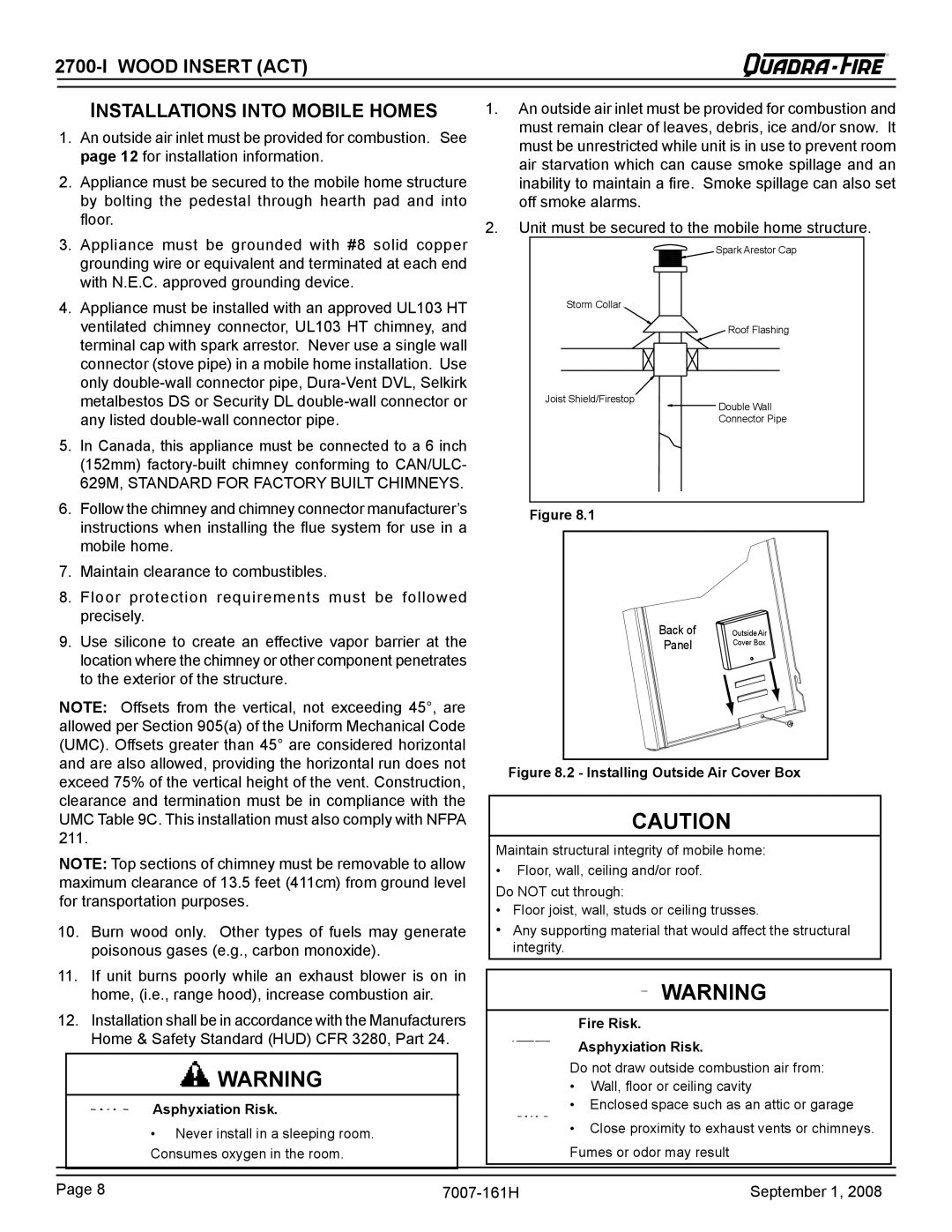
2700-I WOOD INSERT (ACT)
R
INSTALLATIONS INTO MOBILE HOMES
1. | An outside air inlet must be provided for combustion. See |
| page 12 for installation information. |
2. | Appliance must be secured to the mobile home structure |
| by bolting the pedestal through hearth pad and into |
| floor. |
3. | Appliance must be grounded with #8 solid copper |
1.An outside air inlet must be provided for combustion and must remain clear of leaves, debris, ice and/or snow. It must be unrestricted while unit is in use to prevent room air starvation which can cause smoke spillage and an inability to maintain a fire. Smoke spillage can also set off smoke alarms.
2.Unit must be secured to the mobile home structure.
| grounding wire or equivalent and terminated at each end |
| with N.E.C. approved grounding device. |
4. | Appliance must be installed with an approved UL103 HT |
| ventilated chimney connector, UL103 HT chimney, and |
| terminal cap with spark arrestor. Never use a single wall |
| connector (stove pipe) in a mobile home installation. Use |
| only |
| metalbestos DS or Security DL |
| any listed |
5. | In Canada, this appliance must be connected to a 6 inch |
| (152mm) |
| 629M, STANDARD FOR FACTORY BUILT CHIMNEYS. |
6. | Follow the chimney and chimney connector manufacturer’s |
| instructions when installing the flue system for use in a |
| mobile home. |
7. | Maintain clearance to combustibles. |
8. | Floor protection requirements must be followed |
| precisely. |
Storm Collar
Joist Shield/Firestop
Figure 8.1
Spark Arestor Cap
![]() Roof Flashing
Roof Flashing
![]() Double Wall
Double Wall
Connector Pipe
9. Use silicone to create an effective vapor barrier at the |
location where the chimney or other component penetrates |
to the exterior of the structure. |
NOTE: Offsets from the vertical, not exceeding 45°, are allowed per Section 905(a) of the Uniform Mechanical Code (UMC). Offsets greater than 45° are considered horizontal and are also allowed, providing the horizontal run does not exceed 75% of the vertical height of the vent. Construction, clearance and termination must be in compliance with the UMC Table 9C. This installation must also comply with NFPA 211.
NOTE: Top sections of chimney must be removable to allow maximum clearance of 13.5 feet (411cm) from ground level for transportation purposes.
10.Burn wood only. Other types of fuels may generate poisonous gases (e.g., carbon monoxide).
11.If unit burns poorly while an exhaust blower is on in home, (i.e., range hood), increase combustion air.
12.Installation shall be in accordance with the Manufacturers
Home & Safety Standard (HUD) CFR 3280, Part 24.
![]() WARNING
WARNING
Asphyxiation Risk.
•Never install in a sleeping room.
Consumes oxygen in the room.
Back of | Outside Air |
Panel | Cover Box |
|
Figure 8.2 - Installing Outside Air Cover Box
CAUTION
Maintain structural integrity of mobile home:
•Floor, wall, ceiling and/or roof.
Do NOT cut through:
•Floor joist, wall, studs or ceiling trusses.
•Any supporting material that would affect the structural integrity.
WARNING
Fire Risk.
Asphyxiation Risk.
Do not draw outside combustion air from:
•Wall, floor or ceiling cavity
•Enclosed space such as an attic or garage
•Close proximity to exhaust vents or chimneys.
Fumes or odor may result
Page | September 1, 2008 |
